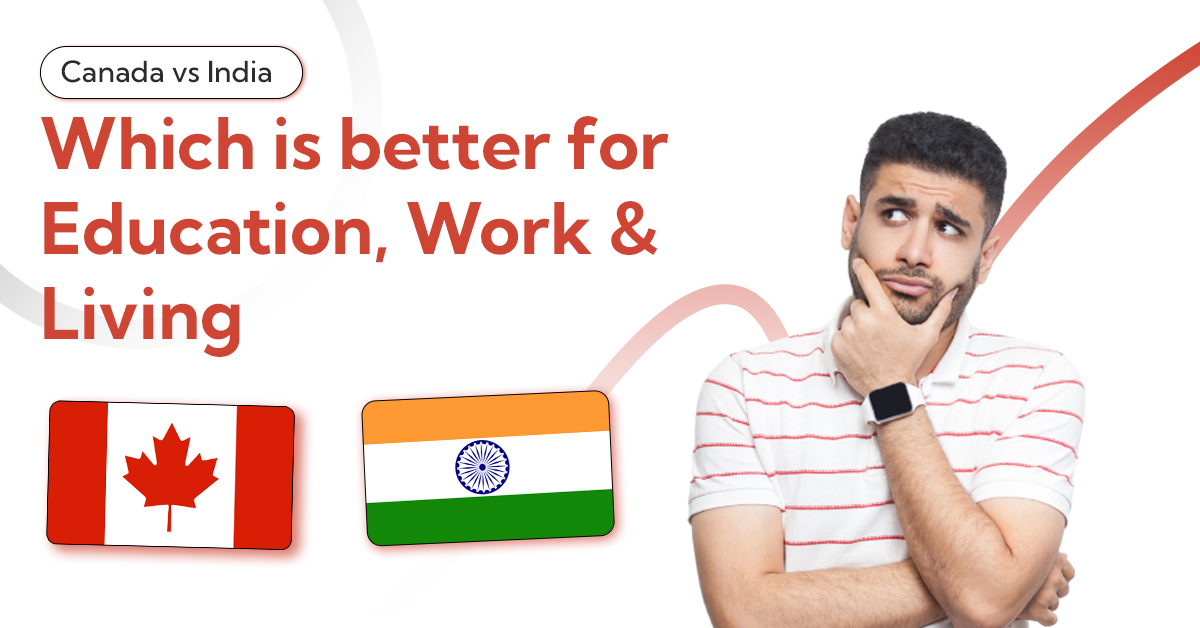When people think of global education, work, and lifestyle opportunities, two countries often come into focus: Canada and India. One is known for its clean cities, structured systems, and multiculturalism. The other is recognized for its growing economy, competitive academics, and cultural richness. For Indian students, professionals, and families planning their future, deciding between the two becomes a matter of careful thought.
Is Canada’s well-established immigration system and public healthcare enough to justify the higher cost of living? Can India’s booming economy and accessible education system compete with Canada’s global career opportunities?
This blog dives deep into Canada vs India, examining every factor that impacts life decisions—education quality, career scope, living costs, lifestyle, immigration rules, and more.
Whether you’re planning to study abroad, explore international job markets, or relocate with your family, this comparison will help you make an informed choice.
Education System Comparison
1. Structure & Accessibility
| Feature | Canada | India |
| Education Level | K-12, UG, PG, Doctoral | Primary, Secondary, UG, PG, Doctoral |
| Language of Instruction | English, French | English, Hindi, Regional |
| Global Ranking of Universities | High | Moderate |
| Student-Teacher Ratio | 12:1 (Avg.) | 30:1 (Avg.) |
| Public Education | Free up to Grade 12 | Free in Govt. schools |
In Canada vs India, Canada stands out for its well-rounded and inclusive education system. Its institutions regularly rank in the Top 100 globally, with practical learning, co-op programs, and international faculty. India, though improving, still faces issues like overcrowded classrooms and theory-heavy instruction in most public universities.
2. Cost of Education
| Program Type | Canada (International Fees/year) | India (Private Colleges/year) |
| UG Degree | CAD 15,000–30,000 | INR 1–4 Lakhs |
| PG Degree | CAD 18,000–35,000 | INR 2–6 Lakhs |
| MBA | CAD 25,000–60,000 | INR 7–25 Lakhs |
While Canada vs India in cost shows a huge gap, Canada offers work permits for students, part-time job options, and a clearer Post-Graduate Work Permit (PGWP) path, making it a strong ROI decision despite upfront costs.
3. Scholarship Availability
| Scholarship | Offered In | Value | Eligibility |
| Vanier Canada Graduate Scholarships | Canada | CAD 50,000/year | Academic excellence, Research |
| Shastri Indo-Canadian Institute | Canada/India | CAD 500–10,000 | UG/PG/Research students |
| Prime Minister’s Research Fellowship | India | INR 70,000–80,000/month | PG & PhD in STEM |
| Commonwealth Scholarship | India to Canada | Full tuition | Based on merit and need |
In comparing Canada vs India, Canada offers scholarships with more global exposure and research focus, while India’s are domestically funded and often limited to top-tier institutes.
Career & Work Opportunities
1. Job Market & Demand
| Sector | Canada | India |
| IT & Tech | High demand | Extremely high demand |
| Healthcare | High demand | Growing steadily |
| Engineering | Consistent | Competitive |
| Education | Steady | Moderate |
| Finance | High | Competitive |
In Canada vs India, both nations show robust job markets. But Canada has a stronger need for skilled labor due to its aging population. Visa sponsorship jobs in UK for Indian students are also commonly compared with Canada’s immigration-friendly jobs.
2. Average Salaries
| Job Role | Canada (CAD/year) | India (INR/year) |
| Software Engineer | 80,000–120,000 | 8–30 Lakhs |
| Registered Nurse | 60,000–90,000 | 3–6 Lakhs |
| Mechanical Engineer | 70,000–100,000 | 4–10 Lakhs |
| Data Analyst | 65,000–95,000 | 5–12 Lakhs |
| Teacher (High School) | 50,000–70,000 | 3–6 Lakhs |
Canada’s average salary is much higher, but so is the cost of living in Canada vs India. In raw numbers, jobs in Canada offer better pay, more benefits, and better work-life balance.
3. Work Permits and Visa Rules
In Canada, international students can work 20 hours per week during academic sessions and full-time during breaks. The PGWP allows graduates to stay up to 3 years, depending on the program length.
In India, foreign students face restrictions on working while studying. Job market access is mostly reserved for local graduates.
For Indian nationals, Canada versus India for career growth often depends on ease of visa, salary, and career mobility. That’s why jobs in UK for Indian with visa sponsorship also emerge in this conversation, but Canada offers a more straightforward process.
Lifestyle & Cost of Living
1. Living Costs
| Expense Type | Canada (CAD/month) | India (INR/month) |
| Rent (1BHK) | 1,200–2,000 | 15,000–35,000 |
| Food & Groceries | 300–600 | 5,000–10,000 |
| Transport | 100–150 | 1,500–3,000 |
| Health Insurance | 75–100 | 500–1,000 |
| Mobile & Internet | 80–120 | 500–1,200 |
The cost of living in Canada vs India shows how Canada is significantly more expensive. However, the quality of life in Canada vs India is also higher, thanks to better infrastructure, healthcare, and public services.
2. Safety, Environment & Social Life
| Factor | Canada | India |
| Public Safety | Very High | Moderate |
| Pollution | Low | High |
| Social Equality | Strong | Improving |
| Language Barriers | English/French | English/Hindi/Regional |
| Healthcare Access | Universal | Varies by income |
In terms of quality of life in Canada vs India, Canada offers cleaner air, safer cities, and better public systems. India, however, has vibrant cultural life, diverse experiences, and stronger family ties.
Immigration & Residency
1. Canada’s Pathways
- Express Entry System: Based on CRS score (age, experience, education).
- Provincial Nominee Program (PNP): Province-led invitations for skilled roles.
- PGWP to PR Path: Many students convert their study permit into permanent residency.
2. India’s Options
- India does not offer an immigration track for foreign nationals like Canada.
- Residency in India is based on long-term visa categories, which are rare.
- Dual citizenship is not allowed for Indian nationals.
In Canada vs India, Canada provides more flexible immigration, especially for skilled workers and international graduates.
Pros and Cons Table
| Factor | Canada | India |
| Quality of Education | Top-tier universities | Affordable options |
| Job Market Access | Global, skill-based | Competitive |
| Cost of Living | Expensive | Affordable |
| Immigration Pathways | Structured & clear | Limited |
| Healthcare | Universal | Subsidized |
| Language Flexibility | English, French | English, Hindi |
| Social Life | Multicultural | Family-oriented |
| Safety & Environment | High | Needs improvement |
Both countries offer unique benefits. The real decision in Canada vs India depends on what you value most: affordability and roots (India) vs. lifestyle, growth, and global mobility (Canada).
Conclusion
When we weigh Canada vs India, the better choice depends on your personal and professional goals.
- If you’re a student looking for international exposure, post-study work rights, and a path to permanent residency, Canada offers immense value.
- If you’re cost-sensitive and want to build a career close to home in a rapidly growing economy, India may be the wiser pick.
- When comparing cost of living in Canada vs India, living cost in Canada vs India, or even Canada cost of living compared to India, Canada is more expensive, but its public services and global credentials often justify the price.
For those looking to study abroad, explore visa sponsorship jobs, or improve their quality of life, Canada may offer more structured and supportive systems. Still, India’s rise as a global powerhouse, especially in sectors like IT and entrepreneurship, makes it a strong contender too.
Whether it’s Canada vs Ireland for Indian students or Canada versus India, the right destination is where your opportunities match your values. If you are still confused, get in touch with our couselors at Transglobal Overseas for expert advice.
Frequently Asked Questions
1. Which country offers better job opportunities for international students — Canada or India?
Canada offers better job opportunities for international students. It has a strong job market, clear work permits, and more part-time options for students compared to India.
2. How does the cost of living compare between Canada and India for students?
Living in Canada is costlier than in India. Rent, food, and travel are more expensive. Students in Canada must plan well to manage their budget.
3. Is Canada safer than India for international students?
Yes Canada is safer compared to India. It is also safer as an international student because it has strict laws, low crime rates, and great support services to students.
4. How does the quality of life differ between Canada and India?
Canada offers a better quality of life with clean air, public services, and balanced work-life culture. India has fast growth but lacks consistent services in most areas.
5. Which country has a better immigration policy for international graduates — Canada or India?
The Immigration policy in Canada is very clear and friendly. International graduates are able to remain and make PR application with ease. India does not provide that to international students.
6. Which country offers better long-term career prospects after graduation?
Canada offers better long-term career growth. It has a global job market, high salaries, and better work culture. India has fewer global roles and slower growth.
7. How does healthcare access and quality compare between the two countries?
Canada offers free public healthcare with high quality, but wait times can be long. In India, healthcare is cheaper but often varies in quality and access.
8. What is the average salary after graduation in Canada vs India?
Graduates in Canada earn around CAD 50,000–60,000 yearly. In India, fresh graduates earn INR 3–5 lakhs per year. Salaries in Canada are much higher overall.




